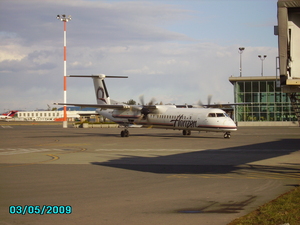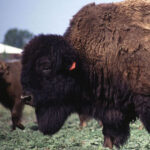On February 12, 2009, a Bombardier Dash 8 Q400 crashed near Buffalo, New York. Continental Connection Flight 3407 was about one minute from landing at Clarence Center airport when it stalled and dove into a house. No one survived the steep descent, which killed 49 people on board and one person in the home. The inevitable question: Is the Q400 a safe airplane?
Flight 3407
The crew had been discussing a “significant icing” condition and turned on the anti-icing system much earlier in the flight. This led to immediate speculation that icing was to blame. Preliminary analysis of the “black boxes” is now suggesting a combination of pilot error, company policy, and training. Standard practice pairs a senior pilot with high hours on the aircraft type with a less experienced one. In this case, the senior pilot had only 1,000 hours on this aircraft. Dash 8 pilots are commenting about the unusual action of the doomed crew. When flying in a significant icing condition, the autopilot is not used in order to feel how the controls are behaving, and a higher speed is maintained as a safety margin. A cardinal rule among most pilots is to avoid dropping the flaps suddenly, if at all, to avoid a stall or “upset”. Under severe conditions the minimum altitude to risk sudden changes to the airplanes configuration is usually 5,000 feet. Flight 3407 lowered both flaps and landing gear while flying at 1,600 feet. The airspeed had been decaying far too low for the conditions, seemingly unnoticed. When the de-icing system is operating on a Dash 8 the “stick shaker” will activate at 130 knots, slightly higher than usual as an added safety measure. The flight computer, while acting as autopilot, reacted to the speed situation by pushing the nose down to gain airspeed (autopilot does not control throttles on the Dash 8). The pilot, who was new to this aircraft but well experienced, reacted by pulling back on the stick quite forcefully, added power, and decided to abort the landing. The plane was still flying, but the 31 degree climb, with 2 G’s at one point, caused a sudden and deep stall. It fell into a sharp right hand bank and lost half of the available altitude, 800 feet, in less than five seconds. The pilots were correctly performing the stall recovery maneuvers all the way to the ground – they just didn’t have enough altitude to regain flight.
Bush Plane Heritage
The Dash 8’s heritage goes back to the original de Havilland Canada bush planes. Built for punishing use in the harshest environments of Canada and the world, they are well known for safety and utility. The ability to carry heavy loads into frighteningly inadequate landing strips and to survive horrific battle damage made them a natural choice for military service. Well over a thousand Beavers, Otters, Caribou and Buffalo’s were used by the US Army in the Korean and Vietnam wars. The Twin Otter, one of very few aircraft able to operate in Antarctic weather, paved the way for the Dash 8. The Q400 model, much longer and quieter than the original 100 series, has been in use since 2000. It is considered to be the most advanced turbo prop in the world and has a Honeywell “glass cockpit”.
Landing Gear Failures
The Q400 was plagued by a number of landing gear malfunctions. Worldwide, 8 of 11 failures occurred in 2007. SAS airlines permanently stopped flying their Q400’s after experiencing three landing gear accidents in a short period of time, including one lost plane due to fire after a main gear failure. Inadequate maintenance by airlines, including SAS, proved to be the cause. Referring to the crash landings, the planes have been called “Crash 8’s. Media comments have compared Flight 3407 to the landing gear incidents, calling the plane a dangerous, poorly built menace that has finally claimed lives. The previous “crashes”, while no doubt harrowing, do not compare to a nose dive into the ground. Bombardier is justly calling the comparison “unfair”. Thankfully, none of the landing accidents resulted in fatalities. Stricter corrosion inspections and maintenance have prevented any further problems.
Dash 8 Safety Record
How many people have been killed in the new Q400’s? The crash in Buffalo is actually the first plane in the series to have a fatal accident.
All types included, over 900 Dash 8’s have been built. The first Dash 8 100’s have been flying since 1984. There have been three fatal accidents involving the models prior to the Q400. In 1990 the crew of a Bangkok Airways Dash 8 became disoriented during a storm and flew into the ground, killing all 38 persons. In 1993, four people were killed when a Lufthansa Cityline Dash 8 struck the ground after suddenly being ordered to change runways. Five were killed in 1995 when an Ansett New Zealand Dash 8 struck high ground in poor weather. None of these accidents were caused by mechanical problems.
Should We Feel Safe In The Dash 8?
So is the Q400, or any other Dash 8, safe? Dash 8’s routinely operate in severe northern environments, including many flights inside the Arctic Circle. The number of fatal crashes should be proportionately higher for many of the flights. The aircraft is built to take icing conditions in stride. A number of Dash 8 pilots agree the Q400, with its advanced systems, should have operated quite normally despite the icing situation. This does not mean ice can’t be deadly to a Dash 8. Advanced capabilities are a breeding ground for complacency.
The entire Dash 8 line enjoys an enviable safety record. Bombardier has certainly advanced the design, but remember the de Havilland design team evolved the Dash 8 from the original work planes. These are built to work hard and get home, every time. Canadians, after all, have an obsession about making things especially safe and sturdy.




